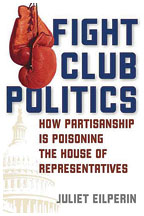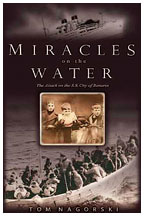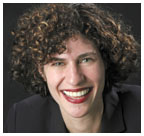July 19, 2006: Reading Room
In her book, Juliet Eilperin ’92 looks at the costs of redistricting along party lines. (courtesy Rowman & Littlefield) |
Fighting
in the House
Juliet Eilperin ’92 examines partisanship in Congress
By Dugald McConnell ’93
For the Record
Juliet Eilperin '92 has worked at The Washington Post since March 1998.
She covered the House of Representatives for six years before she became the
national environmental reporter in April 2004, She continues to write stories
about Congress. Some information about her work at The Post was incorrect
or unclear in a July 19 Reading Room article.
Ten years covering Congress has been long enough for journalist Juliet Eilperin ’92 to see what’s going wrong with the institution. She sounds an alarm in her book Fight Club Politics: How Partisanship Is Poisoning the House of Representatives, published by Rowman & Littlefield in April.
Since the Republicans gained control of the House in 1994, she argues, the middle ground in Congress has disappeared, and members of both parties have become more attentive to the marching orders of their parties than to the needs of their constituents.
Eilperin, a reporter at The Washington Post for the last six years, describes House leaders holding the party-discipline leash tighter than ever: using committee assignments, coveted chairmanships, and political action committee money to reward lockstep loyalists and punish independents. Democratic Rep. Collin Peterson of Minnesota is quoted in the book remarking that pressure to vote with the party can feel like “you’re telling me I should vote against my conscience and vote against my constituents.”
 Worst
of all, Eilperin argues, both parties are rigging the system through redistricting.
The parties draw skewed congressional voting maps, lumping Democrats into
some districts and Republicans into others, maximizing party advantage
and assuring easy re-election. “People don’t realize how few
competitive elections there are,” says Eilperin. In 2002, the Cook
Report political tip sheet listed only 11 out of the 435 races as “toss-ups.”
Worst
of all, Eilperin argues, both parties are rigging the system through redistricting.
The parties draw skewed congressional voting maps, lumping Democrats into
some districts and Republicans into others, maximizing party advantage
and assuring easy re-election. “People don’t realize how few
competitive elections there are,” says Eilperin. In 2002, the Cook
Report political tip sheet listed only 11 out of the 435 races as “toss-ups.”
Party-line redistricting causes two problems, she writes. First, without contested elections to hold them accountable, politicians can afford to ignore their constituents. Second, districts that lean heavily to the left or the right produce representatives who lean heavily to the left or right.
Fight Club Politics discusses a possible remedy: redistricting by a bipartisan commission, as has been done in New Jersey and Arizona, or by a nonpartisan commission, as in Iowa. But Eilperin says her aim in writing the book was not to offer “fixes” but to start a debate.
A Washington, D.C., native who majored in the politics department, Eilperin began as a reporter at The Daily Princetonian. She eventually became a managing editor, and now occasionally contributes to PAW.
She wrote Fight Club Politics at Princeton, during a sabbatical from the Post in the spring of 2005. She taught a political reporting seminar on Tuesday afternoons, and devoted the rest of her time to writing about what she had seen on Capitol Hill.
Some readers may find that her criticisms focus on Republicans, but
Eilperin says that’s because they are the ones currently in control.
As to how her book is being received inside the beltway, “Democrats
are more hostile than I expected,” she says, “and Republicans
are not as upset as I expected.” She says she didn’t have
to pull her punches for fear of offending lawmakers — she has already
transferred to the Post’s environmental beat. ![]()
Dugald McConnell ’93 is a producer with CNN in Washington, D.C.
Tom Nagorski ’84’s great-uncle survived for eight days on a lifeboat in the Atlantic. (Steve Fenn) |
Miracles
on the water
Tom Nagorski ’84 profiles victims of U-boat attack
At 10:03 p.m. on Sept. 17, 1940, a German submarine torpedoed a British passenger liner, City of Benares, heading from England for Canada. It sank within 31 minutes, more than 600 miles from land, with air and water temperatures roughly 50 degrees. Passengers on one lifeboat, known as lifeboat 12, managed to launch safely from the ship, taking little water on board. By the time a British navy ship, the Hurricane, rescued Benares survivors some 18 hours later, lifeboat 12 had drifted so far from the other lifeboats — which were waterlogged and damaged — that it wasn’t found for another seven days.
One of the survivors on lifeboat 12 was a Polish shipping executive, Bohdan Nagorski, Tom Nagorski ’84’s great-uncle, who was on his way to join his family in Canada. Tom Nagorski first heard the story of the Benares during family Christmas gatherings as a teenager. Five years ago, when Nagorski had dinner with Bohdan’s two daughters, conversation wandered again to Bohdan’s experience drifting in a lifeboat in the North Atlantic. By that time Nagorski was a senior producer of ABC’s World News Tonight, and his great-uncle and aunt had died. He wanted to know more, so he read his great-uncle’s written account and press coverage from the time. And he began looking for and interviewing other survivors. What started as a project to capture family history became a book, Miracles on the Water: The Heroic Survivors of a World War II U-Boat Attack, published by Hyperion in March, which begins with the moment of impact and follows passengers and crew members as some lived and some died.
 “The
more I learned, the more I realized that Bohdan’s piece of this
was just one piece in a pretty huge mosaic of drama and courage,”
says Nagorski. On board the Benares were 90 English children who were
evacuees from the German blitz. Their parents had put them on the ship
hoping that they would make it safely to Canada. Miracles on the Water
focuses on those children and their adult escorts. Only 13 children evacuees
were rescued. In all, 258 of the 406 passengers and crew members perished
as a result of the attack.
“The
more I learned, the more I realized that Bohdan’s piece of this
was just one piece in a pretty huge mosaic of drama and courage,”
says Nagorski. On board the Benares were 90 English children who were
evacuees from the German blitz. Their parents had put them on the ship
hoping that they would make it safely to Canada. Miracles on the Water
focuses on those children and their adult escorts. Only 13 children evacuees
were rescued. In all, 258 of the 406 passengers and crew members perished
as a result of the attack.
“It was chance, more than anything, that dictated who would live,” writes Nagorski. On that stormy night some lifeboats pitched over as they were being lowered, throwing people, including five siblings of one family, into the raging waters. John Baker, 7 years old at the time, lived because his 12-year-old brother gave him his life vest and the adults on his lifeboat wrapped him in canvas sheeting, keeping him relatively warm and dry. Michael Rennie, an escort, dove off his lifeboat a dozen times to pull 13 children out of the water. He died before sunrise, probably from exposure, as many other people did that night.
All six evacuee boys and all but one of the 40 adults onboard lifeboat 12 survived the nearly hopeless situation, thanks to sheer will, decorum, and the meticulous rationing of food and water that had been stored in the lifeboat. The children aboard lifeboat 12 and the other lifeboats “behaved with courage, stoicism, and selflessness, because they had ample opportunity to be ... terrified and ... to yank at someone else’s food or lose their wits,” says Nagorski.
By K.F.G.
BOOK SHORTS
 Reporting:
Writings from The New Yorker— David Remnick ’81 (Knopf).
In this anthology of 23 of the author’s New Yorker profiles, Remnick
gets behind the public face of public figures. Included are stories about
Vladimir Putin as he contends with Gorbachev’s legacy, Al Gore as
he tries to make sense of his loss in the 2000 election, and the literary
vision of Philip Roth. Remnick is editor of The New Yorker.
Reporting:
Writings from The New Yorker— David Remnick ’81 (Knopf).
In this anthology of 23 of the author’s New Yorker profiles, Remnick
gets behind the public face of public figures. Included are stories about
Vladimir Putin as he contends with Gorbachev’s legacy, Al Gore as
he tries to make sense of his loss in the 2000 election, and the literary
vision of Philip Roth. Remnick is editor of The New Yorker.
 Oracle Bones:
A Journey Between China’s Past and Present — Peter
Hessler ’92 (HarperCollins). The author tells the story of modern-day
China and its growing links to the West through the lives of ordinary
people, including a teacher; a migrant factory worker; a scholar of oracle-bone
inscriptions, the earliest known writing in East Asia; and a member of
an ethnic minority who moves to the United States. Hessler is the Beijing
correspondent for The New Yorker.
Oracle Bones:
A Journey Between China’s Past and Present — Peter
Hessler ’92 (HarperCollins). The author tells the story of modern-day
China and its growing links to the West through the lives of ordinary
people, including a teacher; a migrant factory worker; a scholar of oracle-bone
inscriptions, the earliest known writing in East Asia; and a member of
an ethnic minority who moves to the United States. Hessler is the Beijing
correspondent for The New Yorker.
 Adolescent
Risk Behaviors: Why Teens Experiment and Strategies to Keep Them Safe
— David A. Wolfe, Peter G. Jaffe, Claire V. Crooks ’95 (Yale
University Press). The authors examine how prevention programs that focus
on developing healthy relationships with peers, romantic partners, parents,
and teachers can help teenagers avoid drug and alcohol abuse, unsafe sexual
practices, and physical and emotional harm from peers and dating partners.
Crooks is a clinical psychologist.
Adolescent
Risk Behaviors: Why Teens Experiment and Strategies to Keep Them Safe
— David A. Wolfe, Peter G. Jaffe, Claire V. Crooks ’95 (Yale
University Press). The authors examine how prevention programs that focus
on developing healthy relationships with peers, romantic partners, parents,
and teachers can help teenagers avoid drug and alcohol abuse, unsafe sexual
practices, and physical and emotional harm from peers and dating partners.
Crooks is a clinical psychologist.
 Timothy;
Or, Notes of an Abject Reptile — Verlyn Klinkenborg *82
(Knopf). The author gives Timothy, a female tortoise — who in real
life lived in the garden of the 18th-century English curate and naturalist
Gilbert White — a voice as she ventures into the countryside and
observes the curious habits of humans. Publishers Weekly called Timothy
“a gorgeous hybrid of naturalist observation, novelistic invention,
and philosophical meditation.” Klinkenborg is a member of the editorial
board at The New York Times.
Timothy;
Or, Notes of an Abject Reptile — Verlyn Klinkenborg *82
(Knopf). The author gives Timothy, a female tortoise — who in real
life lived in the garden of the 18th-century English curate and naturalist
Gilbert White — a voice as she ventures into the countryside and
observes the curious habits of humans. Publishers Weekly called Timothy
“a gorgeous hybrid of naturalist observation, novelistic invention,
and philosophical meditation.” Klinkenborg is a member of the editorial
board at The New York Times.
 The Light at
the Edge — Marilyn Chandler McEntyre *84 (Fithian Press).
In this collection of poems, McEntyre meditates on love and war, happiness
and sorrow. Many of her poems deal with the familiar and the ordinary
— work life, family occasions, folding laundry. Poems in a section
titled “Loving the Enemy” deal with anger and anguish as a
result of the Iraq war. McEntyre is an English professor at Westmont College
in Santa Barbara, Calif.
The Light at
the Edge — Marilyn Chandler McEntyre *84 (Fithian Press).
In this collection of poems, McEntyre meditates on love and war, happiness
and sorrow. Many of her poems deal with the familiar and the ordinary
— work life, family occasions, folding laundry. Poems in a section
titled “Loving the Enemy” deal with anger and anguish as a
result of the Iraq war. McEntyre is an English professor at Westmont College
in Santa Barbara, Calif.
 Richard Estes
— John Wilmerding (Rizzoli). This book includes images
of more than 200 paintings created by the artist Richard Estes during
the last five decades. One of America’s leading photorealist painters,
Estes captures urban landscapes in paintings that resemble photographs.
Wilmerding considers Estes’ work within the context of contemporary
realism and looks at the artist’s themes, techniques, and influences.
Wilmerding is a professor of American art at Princeton.
Richard Estes
— John Wilmerding (Rizzoli). This book includes images
of more than 200 paintings created by the artist Richard Estes during
the last five decades. One of America’s leading photorealist painters,
Estes captures urban landscapes in paintings that resemble photographs.
Wilmerding considers Estes’ work within the context of contemporary
realism and looks at the artist’s themes, techniques, and influences.
Wilmerding is a professor of American art at Princeton. ![]()
By K.F.G.
For a complete list of books received, click here.


